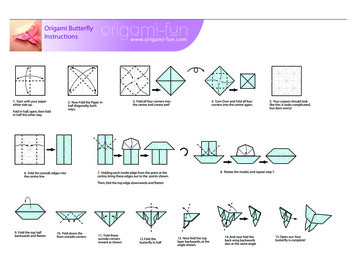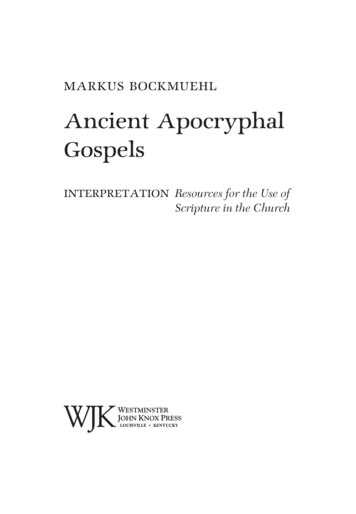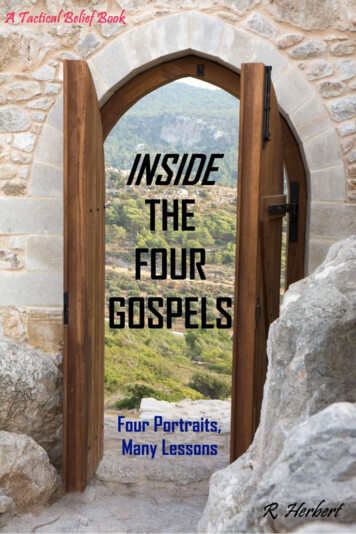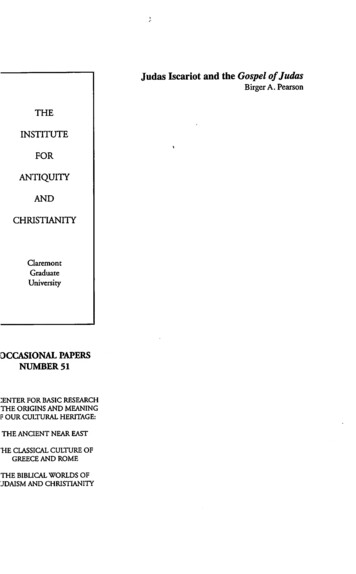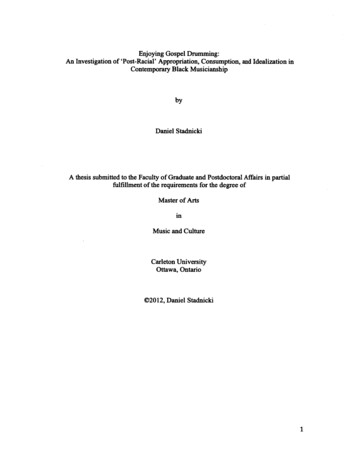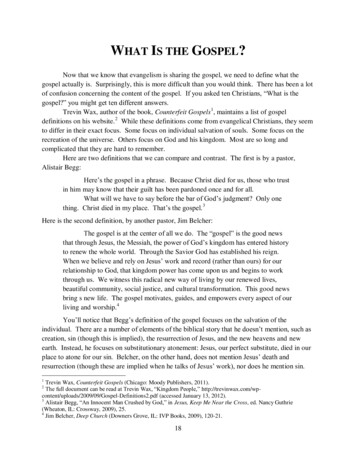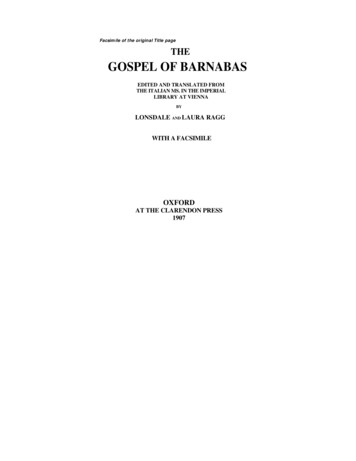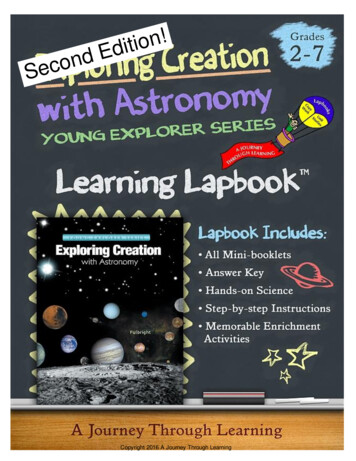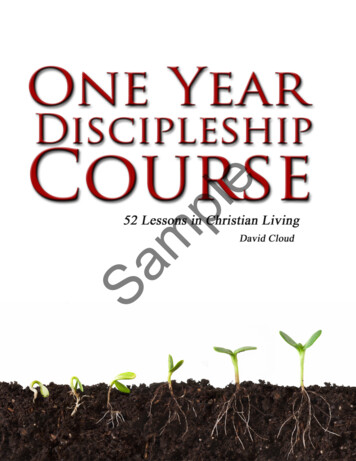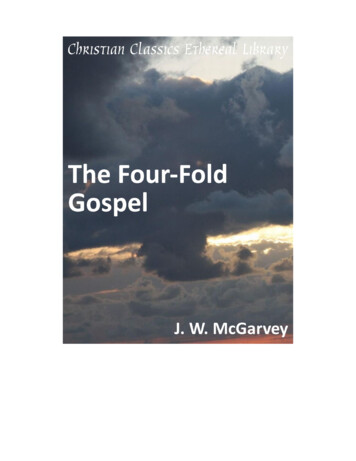
Transcription
The Four-Fold GospelAuthor(s):McGarvey, J. W.Publisher:Grand Rapids, MI: Christian Classics Ethereal LibraryDescription:Subjects:This mixture of gospel harmony (a comparison of identicalstories from each of the gospels, placed in chronological order) and commentary (a verse-by-verse analysis of a passage) by John William McGarvey is a highly technical butincomparably useful guide to the biblical Gospels. McGarvey,a serious student of the Bible and author of many othercommentaries, is at his best here in the unique blend. Usersshould be sure to read the introductory sections in order tounderstand the abbreviations, symbols, and set-up of thevolume to avoid confusion and to get optimal use from thesource. This reference is a wonderful expansion of Gospelcommentaries, and is one of the only books of its kind.Abby ZwartCCEL Staff WriterThe BibleNew TestamentSpecial parts of the New Testamenti
ContentsA Harmony of the Gospels1Introduction.2Preserving the Text.3To Distinguish the Gospels.4Combination Illustrated.5Lesser and Fuller Forms.6Sections and Subdivisions.7Four Points of Economy.8Care in Preparing this Work.9An Object in View.The Period of Christ's Life Prior to His Ministry.1011Luke I. 1-4.12John I. 1-18.13Matt. I. 1-17.15Luke III. 23-38.17Luke I. 5-25.18Luke I. 26-38.22Luke I. 39-56.24Luke I. 57-80.26Matt. I. 18-25.28Luke II. 1-7.32Luke II. 8-20.34Luke II. 21-39.36Matt. II. 1-12.41Matt. II. 13-18.47Matt. II. 19-23; Luke II. 39.50ii
Luke II. 40-52.Beginning of the Ministry of John the Baptist, the Foreunner.Matt. III. 1-12; Mark I. 1-8; Luke III. 1-18.Beginning of Our Lord's Ministry.53575871Matt. III. 13-17; Mark I. 9-11; Luke III. 21-23.72Matt. IV. 1-11; Mark I. 12, 13; Luke IV. 1-13.76John I. 19-34.86John I. 35-51.91John II. 1-11.95John II. 12.99(Time: One Year.)101John II. 13-25.102John III. 1-21.105John III. 22-36.110Matt. IV. 12; Mark I. 14; Luke III. 19, 20; John IV. 1-4.114John IV. 5-42.116Luke IV. 14; John IV. 43-45.125Matt. IV. 17; Mark I. 14, 15; Luke IV. 14, 15126John IV. 46-54.128Matt. IV. 13-16.130Matt. IV. 18-22; Mark I. 16-20; Luke V. 1-11.131Mark I. 21-28; Luke . IV. 31-37.135Matt. VIII. 14-17; Mark I. 29-34; Luke IV. 38-41.138Matt. IV. 23-25; Mark I. 35-39; Luke IV. 42-44.140Matt.VIII. 2-4; Mark I. 40-45; Luke V. 12-16.143Matt. IX. 2-8; Mark II. 1-12; Luke V. 17-26.147Matt. IX. 9; Mark II. 13, 14; Luke V. 27, 28152(Time: One Year.)154John V. 1-47.155Matt. XII. 1-8; Mark II. 23-28; Luke VI. 1-5.166Matt. XII. 9-14; Mark III. 1-6; Luke VI. 6-11.169Matt. XII. 15-21; Mark III. 7-12.171iii
Matt. X. 2-4; Mark III. 13-19; Luke VI. 12-16.173Matt. V. 1, 2; Luke VI. 17-20.178Matt. V. 3-12; Luke VI. 20-26.180Matt. V. 13-16.184Matt. V. 17-48; Luke VI. 27-30, 32-36.186Matt. VI. 1-18.196Matt. VI. 19-34.200Matt. VII. 1-6; Luke VI. 37-42.204Matt. VII. 7-11.207Matt. VII. 12; Luke VI. 31.208Matt. VII. 13-23; Luke VI. 43-45.209Matt. VII. 24-29; Luke VI. 46-49.212Matt. VIII. 1, 5-13; Luke VII. 1-10.214Luke VII. 11-17.217Matt. XI. 2-30; Luke VII. 18-35.219Luke VII. 36-50.227Luke VIII. 1-3.232Matt. XII. 22-37; Mark III. 19-30; Luke XI. 14-23.234Matt. XII. 38-45; Luke XI. 24-36.239Matt. XII. 46-50; Mark III. 31-35; Luke VIII. 19-21.243Luke XI. 37-54.245Luke XII. 1-59.248Luke XIII. 1-9.255Matt. XIII. 1-3; Mark IV. 1, 2; Luke VIII. 4.257Matt. XIII. 3-23; Mark IV. 3-25; Luke VIII. 5-18.258Mark IV. 26-29.263Matt. XIII. 24-30.264Matt. XIII. 31-35; Mark IV. 30-34.265Matt. XIII. 36-43.267Matt. XIII. 44-53.268Matt. VIII. 18-27; Mark IV. 35-41; Luke VIII. 22-25.270Matt. VIII. 28-34; IX. 1; Mark V. 1-21; Luke VIII. 26-40.272iv
Matt. IX. 10-17; Mark II. 15-22; Luke V. 29-39.276Matt. IX. 18-26; Mark V. 22-43; Luke VIII. 41-56.279Matt. IX. 27-34.282Matt. XIII. 54-58; Mark VI. 1-6; Luke IV. 16-31.283Matt. IX. 35-38; X. 1, 5-42; XI. 1; Mark VI. 6-13; Luke IX. 1-6.286Matt. XIV. 1-12; Mark VI. 14-29; Luke IX. 7-9.291Matt. XIV. 13; Mark VI. 30-32; Luke IX. 10; John VI. 1.294Matt. XIV. 13-21; Mark VI. 33-44; Luke IX. 11-17; John VI. 2-14.295Matt. XIV. 22-36; Mark VI. 45-56; John VI. 15-21.298John VI. 22-71.301(Time: One Year Less One Week.)308Matt. XV. 1-20; Mark VII. 1-23; John VII. 1.309Matt. XV. 21; Mark VII. 24.313Matt. XV. 22-28; Mark VII. 24-30.314Matt. XV. 29; Mark VII. 31.316Matt. XV. 30-39; Mark VII. 32-VIII. 9.317Matt. XV. 39-XVI. 12; Mark VIII. 10-26.319Matt. XVI. 13-20; Mark VIII. 27-30; Luke IX. 18-21.322Matt. XVI. 21-28; Mark VIII. 31-38; IX. 1; Luke IX. 22-27.326Matt. XVII. 1-13; Mark IX. 2-13; Luke IX. 28-36.329Matt. XVII. 14-20; Mark IX. 14-29; Luke IX. 37-43.332Matt. XVII. 22, 23; Mark IX. 30-32; Luke IX. 43-45.335Matt. XVII. 24-27.336Matt. XVIII. 1-14; Mark IX. 33-50; Luke IX. 46-50.338Matt. XVIII. 15-35.342John VII. 2-9.345Luke IX. 51-56; John VII. 10.347Luke IX. 57-62.348John VII. 11-52.349John VII. 53-VIII. 11.354John VIII. 12-59.356John IX. 1-41.362v
John X. 1-21.366Luke X. 1-24.369Luke X. 25-37.371Luke X. 38-42.373Luke XI. 1-13.374Luke XIII. 10-21.376John X. 22-42.378Luke XIII. 22-35.381Luke XIV. 1-24.384Luke XIV. 25-35.388Luke XV. 1, 2.390Luke XV. 3-7.391Luke XV. 8-10.392Luke XV. 11-32.393Luke XVI. 1-18.396Luke XVI. 19-31.400Luke XVII. 1-10.404John XI. 1-46.406John XI. 47-54.412Luke XVII. 11-37.414Luke XVIII. 1-8.418Luke XVIII. 9-14.420Matt. XIX. 1-12; Mark X. 1-12.422Matt. XIX. 13-15; Mark X. 13-16; Luke XVIII. 15-17.425Matt. XX. 17-28; Mark X. 32-45; Luke XVIII. 31-34.427Matt. XX. 29-34; Mark X. 46-52; Luke XVIII. 35-43.431Luke XIX. 1-28.434Last Week of Our Lord's Ministry, the Fourth Passover, the Crucifixion.438John XI. 55-57; XII. 1-11; Matt. XXVI. 6-13; Mark XIV. 3-9.439Matt. XXI. 1-12, 14-17; Mark XI. 1-11; Luke XIX. 29-44; John XII. 12-19.442Matt. XXI. 18, 19, 12, 13; Mark XI. 12-18; Luke XIX. 45-48.448Matt. XXI. 20-22; Mark XI. 19-25; Luke XXI. 37, 38.450vi
Matt. XXI. 23-27; Mark XI. 27-33; Luke XX. 1-8.452Matt. XXI. 28-32.454Matt. XXI. 33-46; Mark XII. 1-12; Luke XX. 9-19.456Matt. XXII. 1-14.460Matt. XXII. 15-22; Mark XII. 13-17; Luke XX. 20-26.462Matt. XXII. 23-33; Mark XII. 18-27; Luke XX. 27-39.465Matt. XXII. 34-40; Mark XII. 28-34; Luke XX. 40.467Matt. XXII. 41-46; Mark XII. 35-37; Luke XX. 41-44.469Matt. XXIII. 1-39; Mark XII. 38-40; Luke XX. 45-47.470Mark XII. 41-44; Luke XXI. 1-4.474John XII. 20-50.475Matt. XXIV. 1-28; Mark XIII. 1-23; Luke XXI. 5-24.480Matt. XXIV. 29-51; Mark XIII. 24-37; Luke XXI. 25-36.487Matt. XXV. 1-46.491Matt. XXVI. 1-5, 14-16; Mark XIV. 1, 2, 10, 11; Luke XXII. 1-6.495Matt. XXVI. 17-20; Mark XIV. 12-17; Luke XXII. 7-18, 24-30.497John XIII. 1-20.500John XIII. 21-38.503Matt. XXVI. 26-29; Mark XIV. 22-25; Luke XXII. 19, 20; I. Cor. XI. 23-26.507John XIV.-XVI.509John XVII.521Matt. XXVI. 30, 36-46; Mark XIV. 26, 32-42; Luke XXII. 39-46; John XVIII. 1.525Matt. XXVI. 47-56; Mark XIV. 43-52; Luke XXII. 47-53; John XVIII. 2-11.528John XVIII. 12-14, 19-23.532Matt. XXVI. 57, 59-68; Mark XIV. 53, 55-65; Luke XXII. 54, 63-65; John XVIII.24.534John XVIII. 15-18, 25-27.537Matt. XXVII. 1, 2; Mark XV. 1; Luke XXII. 66-23:1; John XVIII. 28.539Matt. XXVII. 11-14; Mark XV. 2-5; Luke XXIII. 2-5; John XVIII. 28-38.541Luke XXIII. 6-12.545Matt. XXVII. 15-30; Mark XV. 6-19; Luke XXIII. 13-25; John XVIII. 39-XIX 16.546Matt. XXVII. 3-10; Acts I. 18, 19.552vii
Matt. XXVII. 31-34; Mark XV. 20-23; Luke XXIII. 26-33; John XIX. 17.554Matt. XXVII. 35-44; Mark XV. 24-32; Luke XXIII. 33-43; John XIX. 18-27.556Matt. XXVII. 45-56; Mark XV. 33-41; Luke XXIII. 44-49; John XIX. 28-30.559Matt. XXVII. 57-66; Mark XV. 42-47; Luke XXIII. 50-56; John XIX. 31-42.562(Time, Forty Days. Spring a.d. 30.)566Matt. XXVIII. 1-8; Mark XVI. 1-8; Luke XXIV. 1-8, 12; John XX. 1-10.567Matt. XXVIII. 9, 10; Mark XVI. 9-11; Luke XXIV. 9-11; John XX. 11-18.570Matt. XXVIII. 11-15.573Mark XVI. 12, 13; Luke XXIV. 13-35; I. Cor. XV. 5.575Mark XVI. 14; Luke XXIV. 36-43; John XX. 19-25.578John XX. 26-31; I. Cor. XV. 5.580John XXI. 1-25.581Matt. XXVIII. 16, 17; I Cor. XV. 6.586Matt. XXVIII. 18-20; Mark XVI. 15-18; Luke XXIV. 46, 47.587Luke XXIV. 44-49; Acts I. 3-8; I. Cor. XV. 7.589Mark XVI. 19, 20; Luke XXIV. 50-53; Acts I. 9-12.591I Cor. XV. 8.592Indexes593Index of Scripture References594Index of Scripture Commentary601Index of Pages of the Print Edition603viii
This PDF file is from the Christian Classics Ethereal Library, www.ccel.org. The mission ofthe CCEL is to make classic Christian books available to the world. This book is available in PDF, HTML, Kindle, and other formats. Seehttp://www.ccel.org/ccel/mcgarvey/gospels.html. Discuss this book online at http://www.ccel.org/node/3408.The CCEL makes CDs of classic Christian literature available around the world through theWeb and through CDs. We have distributed thousands of such CDs free in developingcountries. If you are in a developing country and would like to receive a free CD, pleasesend a request by email to cd-request@ccel.org.The Christian Classics Ethereal Library is a self supporting non-profit organization atCalvin College. If you wish to give of your time or money to support the CCEL, please visithttp://www.ccel.org/give.This PDF file is copyrighted by the Christian Classics Ethereal Library. It may be freelycopied for non-commercial purposes as long as it is not modified. All other rights are reserved. Written permission is required for commercial use.ix
A Harmony of the GospelsTHEFOUR-FOLDGOSPELORA Harmony of the GospelsResulting in a complete chronological life of Christ, divided intotitled sections and sub-divisions, with comments injected in the text;especially designed for the use of Sunday-school teachers and advancedpupils.byPresident J. W. McGARVEY, LL. D.andPHILIP Y. PENDLETON, A. B.CINCINNATIThe Standard Publishing CompanyPublishers of Christian LiteratureCOPYRIGHT 1914.THE STANDARD PUBLISHING CO.CINCINNATI, O.[This text is in the public domain.]1
Introduction.Introduction.We feel in placing this work before the public we should accompany it with some wordsof explanation. It is unique, presenting a combination of features never before collected inone work. Harmonies and Fourfold Gospels are plentiful, and we have examined a largenumber of them, beginning with the pioneer work of Tatian. We have sought to utilize allthe good features employed by others, and to introduce several new and helpful inventionsof our own.2
Preserving the Text.Preserving the Text.Believing fully and firmly that the Scriptures are the word of God, we have sought topreserve all that is contained in them, and have, in combining them, regarded it as wrongto take liberties with them. To carry out this reverential idea we have introduced the variantreadings of each Gospel, enclosing them in braces, so that they will not confuse the reader.By doing this we have, according to our count, except in the cases of a few redundant pronouns, only omitted five words of the text, which, if we remember correctly, are three "ands,"and "but" and one "with." To accomplish this almost absolute conservation of the word ofthe text without involving the reader in hopeless confusion, has been no easy task, especiallyin cases where all four Gospels are combined in a single section.3
To Distinguish the Gospels.To Distinguish the Gospels.Then, to enable the reader to discriminate as he reads, we have indicated the particularGospel from which our word or words are taken, by the several superior letters; namely: a,b, c, and d, which stand respectively for the four Gospels, Matthew, Mark, Luke and John.We have followed the punctuation of each Gospel as we have used its words, also giving thepunctuation mark which followed the last word taken.4
Combination Illustrated.Combination Illustrated.To illustrate our method of combination, let us take Section 36, which is a fitting togetherof the following passages, namely:9 And as Jesus passed by from thence, he saw a man, called Matthew,sitting at the place of toll: and he saith unto him, Follow me. And he arose,and followed him.—Matt. ix. 9.13 And he went forth again by the sea side; and all the multitude resortedunto him, and he taught them. 14 And as he passed by, he saw Levi the sonof Alphæus sitting at the place of toll, and he saith unto him, Follow me. Andhe arose and followed him.—Mark ii. 13, 14.27 And after these things he went forth, and beheld a publican namedLevi, sitting at the place of toll, and said unto him, Follow me. 28 And heforsook all, and rose up and followed him.—Luke v. 27, 28.Which three passages are combined as follows:c27 And after these things he went forth, again by the sea side; and allthe multitude resorted unto him, and he taught them. 14 And as he a Jesuspassed by from thence, he saw c and beheld a a man, c a publican, named { acalled} Matthew, c Levi, b the son of Alphæus sitting at the place of toll, andhe saith { c said} unto him, Follow me. 28 And he forsook all, b and he arose{ c rose up} and followed him.Now, in this passage we have retained the redundant pronoun "he" in the phrase he Jesus.Where Luke has the phrase named Matthew, Matthew has the variant reading called Matthew. Where Mark says saith, Luke gives the variant said, and where Mark says arose, Lukesays rose up. By variant reading we mean one which can not be combined with the othertexts so that the combined text will read smoothly.5
Lesser and Fuller Forms.Lesser and Fuller Forms.Moreover, we have endeavoured to use the fullest form, including the words of thoseGospels which have the lesser forms of sentences, except where the sentence ends in aperiod, in which case have given the least form, so that the larger form of the other Gospelsmight be made apparent; as, for instance, this sentence, taken from Matt. xii. 47; Mark iii.32; Luke viii. 20: c 20 And it was told him, a Behold, thy mother and thy brethren bseekfor thee. c stand without desiring to see thee. a seeking to speak to thee. Here Mark hasthe short form, Luke a longer form, and Matthew a trifle the longest form; all of which isindicated by the order in which each part is placed, and the several periods which close thethought of each evangelist.But in compiling the work we have bound ourselves by no inflexible rule; for to do sowould, in many instances, make the reading very complex, whereas our first study has beento make the work simple, and to avoid confusing the mind of the reader6
Sections and Subdivisions.Sections and Subdivisions.We have divided the work into sections for analytical purposes, and in order to aid inthe work of indexing and giving cross references. We have arranged the sections in whatwe believe to be the best chronological order, but have not attempted to justify our chronology, because space would not permit. We have also given the time and place of each section,where these things could be ascertained with any degree of accuracy. In this matter, however,we are liable to disappoint many of our readers, because we have been conservative. Thedates and places given in similar works are too often more arbitrary assumptions: there beingso little ground of reason back of them that they do not even justify one in calling themspeculative. Unless we have had some reason for fixing a date or assigning a locality, wehave refrained from doing either, though we have found them freely and positively assertedin such places in similar works.7
Four Points of Economy.Four Points of Economy.By the use of pronounced black letter type we enable to reader to follow the Scripturetext, omitting the comments if he chooses. But by thus combining the four Gospels and interjecting the comment into the text, we have produced the most labor-saving, time-saving,condensed commentary ever placed before the people. Those familiar with commentariescan best realize what this means. Incidents told in one Gospel are repeated in other Gospels,and when a commentator has given his annotations on Matthew, and comes to the samefacts recorded in Mark, or Luke, or John, he wastes his space by printing the duplicate text,and he wastes his reader's time by referring him to his comments in the volume on Matthew.by combining the Gospels for commentary purposes we have saved this space and time.Again, in most commentaries a fifth or sixth of the space is taken up in drawing distinctions between the texts of the four Gospels, while in this work these distinctions are placedbefore the reader's eye, where he can see them for himself at a glance. Moreover, in othercommentaries, which give the text, another sixth or seventh of the work is taken up in reprinting in the notes that portion of the text concerning which the commentator wishes tospeak. Our interjected method avoids all this needless repetition, and makes it possible forus to present the comment with the least preliminary verbiage or introductory setting. Timeis also saved because the reader does not have to look back and forth from the text at thetop of the comment at the bottom of the page. Again, other commentaries lose a largeamount of space by using the King James text. Those which preceded the revision wastespace correcting the translation and modernizing its English: those published since the revision suffer a similar waste by drawing endless comparisons between the two texts. Bychoosing the American revision as the basis for our work, we have a text which needs butlittle explanation or apology, and we are thereby enabled to employ the reader's time andstrength to his best advantage.8
Care in Preparing this Work.Care in Preparing this Work.In preparing this work there has been no sparing of time, labor, or expense. While wehave carefully avoided all conceits, quibblings, and useless refinements, and have studiedto present only that which was useful, helpful, and practical, we have endeavored to put intothe work the results of careful investigation and studious research. Besides theologicaltreatises and works of reference, a full line of commentaries has been used. In some fewcases, where the sections have been simple, from thirty to fifty commentaries have beenconsulted; but in the vast majority of sections between eighty and one hundred commentaries have been searched and sifted. To these painstaking labors of the junior editor, therehas been added the results of the wider researches of the senior editor, effected during a halfcentury of continuous Bible study and teaching. We have not aimed to produce a commentaryfor the textual critic, the theologian, or the professor; but a plain and simple work for allreader's of God's word.9
An Object in View.An Object in View.Moreover, having in view the preparation of a new series of Sunday-school lessons, wehave prepared this work as a basis of such series. As the present International Series handlesmere scraps of the Bible, it is practicable to print the text in quarterlies; but with a serieswhich deals with the whole Bible, larger portions must be assigned for the lessons, and suchprinting of the text in the quarterlies becomes impossible. In such a series the pupil mustbe referred to the Bible itself, and in order that he may have a Bible with comments, we haveprepared the present work, intending to follow it with similar volumes until the entire Bibleis given to the public in this annotated form, if God permit.J. W. MCGARVEY.PHILIP Y. PENDLETON.10
The Period of Christ's Life Prior to His Ministry.Part First.The Period of Christ's Life Prior to His Ministry.11
Luke I. 1-4.I.Luke's Preface and Dedication.CLuke I. 1–4.1c1 Forasmuch as many [of whom we know nothing and have even no tradition] havetaken in hand to draw up a narrative concerning those matters which have been fulfilled[completed, or accomplished according to the divine will] among us, 2 even as they deliveredthem unto us, which from the beginning were eyewitnesses [the apostles were necessarilysuch and there were some few others—Acts i. 21–23] and ministers of the word [the apostleswere ministers, and not ecclesiastical dignitaries] , 3; it seemed good to me also, havingtraced the course of all things accurately from the first [and being therefore thoroughlyfitted to write the gospel], to write unto thee in order [not in chronological, but in topicalorder], most excellent Theophilus [Luke also dedicated the Book of Acts to this man.Nothing is known of Theophilus, but he is supposed to have been a Greek of high officialrank]; 4 that thou mightest know the certainty [might have a fixed written record, and nottrust to a floating, variable tradition or a treacherous memory] concerning the things [thegospel facts] wherein thou wast instructed.21* NOTE.—The four Gospels are respectively represented in this volume by the superior letters a, b, c, andd; and variations in the readings of the four Gospels are inserted in braces, thus: { }.12
John I. 1-18.II.John's Introduction.DJohn I. 1–18.d1 In the beginning was the Word [a title for Jesus peculiar to the apostle John], andthe Word was with God [not going before nor coming after God, but with Him at the beginning], and the Word was God. [Not more, not less.] 2 The same was in the beginningwith God. 3 All things were made through him [the New Testament often speaks of Christas the Creator—see ver. 10; I. Cor. viii. 6; Col. i. 13, 17; Heb. i. 2]; and without him was notanything made that hath been made. [This shows that Jesus himself is not a creature.] 4In his was life [As in the Father (chap. v. 26 ). As this life animates the living, so can it reanimate the dead—John xi. 25]; and the life was the light of men. [The life of Jesus is the lightof men, because from that life we get our intellect and understanding, and because that lifeformed and governs the creation around us by which we become enlightened as to the existence and power of God—Rom. i. 18–21; Acts xiv. 16, 17.] 5 And the light shineth in thedarkness [an ignorant, benighted world]; and the darkness apprehended it not. [Did notreceive or admit it. Jesus, the Light of the world, was despised and rejected by men.] 6 Therewas a man sent from God, whose name was John. 7 The same came for witness, that hemight bear witness of the light. [that he might tell men that Jesus was the Messiah], thatall [who heard his testimony] might believe [in Jesus] through him. 8 He was not the light[“He was the lamp that burneth and shineth” ( chap. v. 35); but not the Sun of righteousness—Mal. iv. 2], but came that he might bear witness of the light. 9 There was the true light[as opposed to the imperfect, incomplete, and transitory lights], even the light which lightethevery man [all men are enlightened in some degree and enlightened of Christ: some bynature, some by conscience, and some by Bible revelation], coming into the world. 10 Hewas in the world. [invisibly present, renewing and sustaining his creation], and the worldwas made through him, and the world knew him not. [Though it might and should haveknown him—Rom. i. 18–21; Acts xiv. 16, 17.] 11 He came [visibly in the flesh] unto hisown [his own land or possessions—Hos. ix. 3; Jer. ii. 7; Zech. ii. 12], and they that were hisown [the children of Israel—Ex. xix. 5; Deut. vii. 6; xiv. 2] received him not. 12 But as manyas received him [whether Jew or Gentile], to them gave he the right to become childrenof God [comp. Rom. iii. 14–17; Gal. iii. 26; iv. 6, 7; I. John iii. 1, 2], even to them that believeon his name: 13 who were born, not of blood [descent from Abraham, David or any othergodly person does not make a man a child of God—Luke iii. 8; Matt. iii. 9; ch. viii. 39, 40;Gal. iii. 6, 7, 29], nor of the will of the flesh [the efforts and exertions of our own humanhearts and natures may reform, but can not regenerate, the life—ch. iii. 6], nor of the will133
John I. 1-18.of man [we are not begotten of God by the acts and deeds of our fellow-men, however muchthey may aid us in leading right lives], but of God. [ Ch. iii. 5; I. John iv. 7; v. 1.] 14 Andthe Word became flesh [by being born in Bethlehem of the Virgin Mary], and dwelt amongus, (and we beheld his glory [in his miracles, and especially in his transfiguration—ch. ii.11; II. Pet. i. 16–18], glory as of the only begotten from the Father) [such glory as wassuitable to the Son of God], full of grace and truth. [The glory of Christ was not in pompand worldly grandeur, but in the holiness, grace, and truth of his daily life.] 15 John [theBaptist] beareth witness of him [the words of John the Baptist still witness to unbelievingJews and Gentiles], and crieth, saying, This was he of whom I said [John had preachedabout Jesus before Jesus appeared; he now points to Jesus as the one about whom he hadpreached] , He that cometh after me [He for whom I as a forerunner have prepared theway—Matt. iii. 3] is become before me [is worthy of more honor and reverence than amI] : for he was before me. [Though born into the world six months later than John, Jesus,as the Word, had existed from eternity. (In verse 16 the words are the apostle John's, andnot John the Baptist's.)] 16 For of his fulness [Jesus was full of grace and truth—and all theattributes of God—Eph. i. 23; iii. 19; iv. 13; Col. i. 19; ii. 9] we all received [by union withhim all his perfection and righteousness became ours—Phil. i. 10, 11; iii. 8, 9; I. Cor. i. 30],and grace for grace. [This may mean that we receive a grace kindred to or like each severalgrace that is in Christ (Rom. viii. 29; xii. 2; Eph. iv. 11–13). But it more probably meansfullness of grace, or fresh grace daily added to the grace already bestowed.] 17 For the law[the Old Dispensation with its condemnation (Rom. iii. 20; Gal. ii. 21) and its types andshadows—Col. ii. 16, 17; Heb. viii. 4, 5; x. 1] was given through Moses [by angels at Mt.Sinai—Heb. ii. 2]; grace and truth [the New Dispensation with its justification (Rom. iii.21–26) and its realities— Heb. ix. 1–15] came through Jesus Christ. [Heb. i. 1, 2; ii. 3.] 18No man hath seen God at any time [I. John iv. 12, 20; ch. i. 18; I. Tim. vi. 16]; the only begotten Son [the word “only begotten” indicates that none other bears with Christ a like relationship to God], who is in the bosom of the Father [who bears the closest and tenderestrelationship and fellowship as to the Father] , he hath declared him. [Ch. iii. 2; ch. xv. 9;Col. i. 15.]4514
Matt. I. 1-17.III.Genealogy of Jesus According to Matthew.AMatt. I. 1–17.a1 The book of the generation [or genealogy] of Jesus Christ, the son of David [theMessiah was promised to David—II. Sam. vii. 16; John vii. 42], the son of Abraham.[Messiah was also promised to Abraham—Gen. xxii. 18; Gal. iii. 16.] 2 Abraham begatIsaac; and Isaac begat Jacob; and Jacob begat Judah and his brethren [mentioned herebecause they were the heads of the tribes for whom especially Matthew wrote his Gospel];3 and Judah begat Perez and Zerah [these two were twins] of Tamar [she was the incestuousdaughter-in-law of Judah]; and Perez begat Hezron; and Hezron begat Ram; 4 and Rambegat Amminadab; and Amminadab begat Nahshon; and Nahshon begat Salmon; 5 andSalmon begat Boaz of Rahab [she had been a heathen and a harlot of Jericho]; and Boazbegat Obed of Ruth [she was a heathen Moabitess]; and Obed begat Jesse; 6 and Jessebegat David the king. [These fourteen were patriarchs. The second fourteen were all kings.]And David [we may count David twice, first as a patriarch, second as one of the kings; andthus make up the full number of the second fourteen] begat Solomon of her that had beenthe wife [the adulteress Bathsheba] of Uriah; 7 and Solomon [a wise but sinful king] begatRehoboam [a foolish king, from whose kingdom of twelve tribes God cut off ten tribes];and Rehoboam begat Abijah [a sinful king, like his father Rehoboam]; and Abijah begatAsa [a godly king who reformed his kingdom of Judah]; 8 and Asa begat Jehoshaphat [agood king, much like his father Asa; but he displeased God somewhat by being too friendlywith Ahab, the wicked king of Israel]; and Jehoshaphat begat Joram [Joram married Athaliah, the wicked daughter of Ahab, and followed Ahab in all his ungodly practices]; andJoram [Joram begat Ahaziah, and Ahaziah begat Joash, and Joash begat Amaziah; andAmaziah begat Uzziah. The names of Ahaziah, Joash, and Amaziah were probably omittedfor the sake of symmetry, but may have been dropped because they were wicked descendantsof Ahab unto the fourth generation—Ex. xx. 4, 5] begat Uzziah [he was a good king, butsmitten with leprosy for presumptuously entering the temple]; 9 and Uzziah begat Jotham[a good king like Uzziah, his father]; and Jotham begat Ahaz [one of Judah's worst kings];and Ahaz begat Hezekiah [a royal, godly king, like David]; 10 and Hezekiah begat Manasseh[an evil king, like Ahaz, but, being punished of God, he repented]; and Manasseh begatAmon [an evil king like his father Manasseh; who waxed worse and worse till his peopleconspired against him and slew him]; and Amon begat Josiah [a good king, much likeHezekiah]; 11 and Josiah begat [Jehoiakim, and Jehoiakim begat] Jechoniah and hisbrethren [So far as is known, Jechoniah had no literal brothers. We may, therefore, take the156
Matt. I. 1-17.word “brethren” as meaning his royal kindred; viz.: his father Jehoiakim, and his uncles,Jehoahaz and Zedekiah, the three sons of Josiah], at the time [probably about b.c. 599] ofthe carrying away [into captivity] to Babylon. 12 And after the carrying away to BabylonJechoniah [If we do not count David twice, as above indicated (as a patriarch and a king),we must count Jechoniah twice (as a king who became a citizen). But if we count Jehoiakimas properly included in the phrase “his brethren” at verse 11, we need count no one twice]begat Shealtiel [Luke calls Shealtiel the son of Neri Jechoniah may have been the natural,and Neri the legal, father of Shealtiel—Deut. xxv. 5–10; Matt. xxii. 24. Or Luke's Shealtieland Zerubbabel may have been different persons from the Shealtiel and Zerubbabel ofMatthew] ; and Shealtiel begat Zerubbabel [the governor of Jerusalem, who rebuilt th
The Four-Fold Gospel Author(s): McGarvey, J.W. Publisher: Grand Rapids, MI: Christian Classics Ethereal Library Description: This mixture of gospel harmony (a comparison of identical stories from each of the gospels , placed in chronological or-der) and commentary (a verse-by-verse analysi
